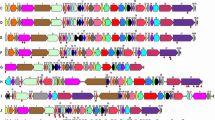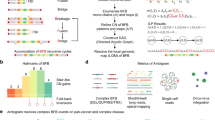Abstract
The domestic dog continues to represent an influential model organism for comparative biomedical research owing to the numerous genetic and pathophysiological similarities shared between human and dog diseases. The combined availability of a high-quality genome assembly and a 1 Mb-resolution genome-assembly integrated bacterial artificial chromosome (BAC) panel now provides the essential resources to combine cytogenetic and computational analyses to determine the precise locations of chromosome breakpoint regions within aberrant karyotypes. In this study we demonstrate the synergy of using a such a combined in-situ/in-silico approach to define chromosome breakpoints using the naturally occurring breakpoint present on all canine X chromosomes—the pseudoautosomal breakpoint (PAB). In so doing we have further characterized the canine pseudoautosomal region (PAR) to extend approximately 6.6 Mb from the telomeric end of CFA Xp and established that the canine PAB is contained within a 2 kb region. Our characterization of the canine PAR allowed for the comparative study of gene content across previously defined mammalian PARs and indicates that the canine PAB is contained with the gene Shroom2. The future application of the approach demonstrated in this study will prove useful when seeking to identify the genomic sequences surrounding recurrent chromosome breakpoints present in canine cancers.



Similar content being viewed by others
Abbreviations
- aCGH:
-
array-based comparative genome hybridization
- BAC:
-
bacterial artificial chromosome
- BLAST:
-
Basic Local Alignment and Search Tool
- BLASTn:
-
Basic Local Alignment and Search Tool for nucleotides
- CFA:
-
Canis familiaris
- CHORI-82:
-
Children’s Hospital Oakland Research Institute – 82 dog BAC library
- FISH:
-
fluorescence in-situ hybridization
- HAS:
-
Homo sapiens
- PAB:
-
pseudoautosomal boundary
- PAR:
-
pseudoautosomal region
- RPCI-81:
-
Roswell Park Cancer Institute – 81 dog BAC library
- UCSC:
-
University of California, Santa Cruz
References
Altschul SF, Madden TL, Schaffer AA et al. (1997) Gapped BLAST and PSI-BLAST: a new generation of protein database search programs. Nucleic Acids Res 25: 3389–3402.
Blaschke RJ, Rappold G (2006) The pseudoautosomal regions, SHOX and disease. Curr Opin Genet Dev 16: 233–239.
Breen M (2008) Canine cytogenetics–from band to basepair. Cytogenet Genome Res 120: 50–60.
Breen M, Langford CF, Carter NP et al. (1999) Fish mapping and identification of canine chromosomes. J Hered 90: 27–30.
Breen M, Hitte C, Lorentzen TD et al. (2004) An integrated 4249 marker FISH/RH map of the canine genome. BMC Genomics 5: 65.
Bussell JJ, Pearson NM, Kanda R, Filatov DA, Lahn BT (2006) Human polymorphism and human–chimpanzee divergence in pseudoautosomal region correlate with local recombination rate. Gene 368: 94–100.
Chowdhary BP, Raudsepp T (2008) The horse genome derby: racing from map to whole genome sequence. Chromosome Res 16: 109–127.
Ellis N, Goodfellow PN (1989) The mammalian pseudoautosomal region. Trends Genet 5: 406–410.
Ellis NA, Tippett P, Petty A et al. (1994a) PBDX is the XG blood group gene. Nat Genet 8: 285–290.
Ellis NA, Ye TZ, Patton S et al. (1994b) Cloning of PBDX, an MIC2-related gene that spans the pseudoautosomal boundary on chromosome Xp. Nat Genet 6: 394–400.
Filatov DA, Gerrard DT (2003) High mutation rates in human and ape pseudoautosomal genes. Gene 317: 67–77.
Iwase M, Satta Y, Hirai Y, Hirai H, Imai H, Takahata N (2003) The amelogenin loci span an ancient pseudoautosomal boundary in diverse mammalian species. Proc Natl Acad Sci U S A 100: 5258–5263.
Iwase M, Kaneko S, Kim H, Satta Y, Takahata N (2007) Evolutionary history of sex-linked mammalian amelogenin genes. Cells Tissues Organs 186: 49–59.
Kirkness EF, Bafna V, Halpern AL et al. (2003) The dog genome: Survey sequencing and comparative analysis. Science 301: 1898–1903.
Langford CF, Fischer PE, Binns MM, Holmes NG, Carter NP (1996) Chromosome-specific paints from a high-resolution flow karyotype of the dog. Chromosome Res 4: 115–123.
Lindblad-Toh K, Wade CM, Mikkelsen TS et al. (2005) Genome sequence, comparative analysis and haplotype structure of the domestic dog. Nature 438: 803–819.
Mangs AH, Morris BJ (2007) The human pseudoautosomal region (PAR): Origin, function and future. Current Genomics 8: 129–136.
Murphy WJ, Davis B, David VA et al. (2007) A 1.5- Mb-resolution radiation hybrid map of the cat genome and comparative analysis with the canine and human genomes. Genomics 89: 189–196.
Park SH, Shin YK, Suh YH et al. (2005) Rapid divergency of rodent CD99 orthologs: implications for the evolution of the pseudoautosomal region. Gene 353: 177–188.
Perry J, Palmer S, Gabriel A, Ashworth A (2001) A short pseudoautosomal region in laboratory mice. Genome Res 11: 1826–1832.
Raudsepp T, Chowdhary BP (2008) The horse pseudoautosomal region (PAR): characterization and comparison with the human, chimp and mouse PARs. Cytogenet Genome Res 121: 102–109.
Roberto R, Capozzi O, Wilson RK et al. (2007) Molecular refinement of gibbon genome rearrangements. Genome Res 17: 249–257.
Spriggs HF, Holmes NG, Breen MG et al. (2003) Construction and integration of radiation-hybrid and cytogenetic maps of dog chromosome X. Mamm Genome 14: 214–221.
Strachan TR, Andrew P (2004) The human X and Y chromosomes exhibit substantial regions of sequence homology, including pseudoautosomal regions. In: Kingston F, ed. Human Molecular Genetics 3. New York: Garland, pp. 367–368.
Thomas R, Scott A, Langford CF et al. (2005) Construction of a 2- Mb resolution BAC microarray for CGH analysis of canine tumors. Genome Res 15: 1831–1837.
Thomas R, Duke SE, Bloom SK et al. (2007) A cytogenetically characterized, genome-anchored 10- Mb BAC set and CGH array for the domestic dog. J Hered 98: 474–484.
Thomas R, Duke SE, Karlsson E et al. (2008) Development of a 1 Mb resolution genome integrated canine BAC resource—application for cytogenetic analysis and array based comparative genomic hybridization. Cytogenet Genome Res (in press).
Toder R, Glaser B, Schiebel K et al. (1997) Genes located in and near the human pseudoautosomal region are located in the X–Y pairing region in dog and sheep. Chromosome Res 5: 301–306.
Author information
Authors and Affiliations
Corresponding author
Rights and permissions
About this article
Cite this article
Young, A.C., Kirkness, E.F. & Breen, M. Tackling the characterization of canine chromosomal breakpoints with an integrated in-situ/in-silico approach: The canine PAR and PAB. Chromosome Res 16, 1193–1202 (2008). https://doi.org/10.1007/s10577-008-1268-9
Received:
Revised:
Accepted:
Published:
Issue Date:
DOI: https://doi.org/10.1007/s10577-008-1268-9




